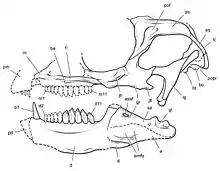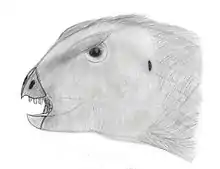Manidens
Manidens is a genus of heterodontosaurid dinosaur from the Middle Jurassic of Patagonia. Fossils have been found in the Cañadón Asfalto Formation in Chubut Province, Argentina, dating to the Bajocian.[1]
| Manidens | |
|---|---|
 | |
| Skull reconstruction | |
| Scientific classification | |
| Kingdom: | Animalia |
| Phylum: | Chordata |
| Clade: | Dinosauria |
| Order: | †Ornithischia |
| Family: | †Heterodontosauridae |
| Subfamily: | †Heterodontosaurinae |
| Genus: | †Manidens Pol et al. 2011 |
| Type species | |
| †Manidens condorensis Pol et al. 2011 | |
Etymology
The type species of Manidens, Manidens condorensis, was described in the journal Naturwissenschaften in 2011. Manidens was named in by Diego Pol, Oliver Rauhut and Marcos Becerra. The generic name is derived from Latin manus, "hand", and dens, "tooth", a reference to the hand-shaped form of the posterior lower teeth. The specific name refers to the village of Cerro Cóndor, located near to the Queso Rallado site where the specimen was found by zoologist Guillermo Rougier.[1]
Description
The holotype specimen of Manidens, MPEF-PV 3211, consists of a partial skeleton with skull and lower jaws, including the axial column except most of the tail; a left shoulder girdle; and the pelvis. The specimens MPEF-PV 1719, 1786, 1718, 3810, 3811, isolated posterior teeth, from the same locality and horizon as the holotype are also referred to this genus. The specimens were found in the Queso Rallado locality of the Cañadón Asfalto Formation, dating to the Aalenian–Early Bathonian stages, 171 ± 5 to 167 ± 4 Ma.[1]
Manidens was a relatively basal heterodontosaurid that grew to about 60 to 75 centimetres (24 to 30 in) in length, smaller than later heterodontosaurids. It has high-crowned teeth indicative of an increased adaptation to a herbivorous diet but lacks the wear facets seen in more advanced forms like Heterodontosaurus. Manidens is the sister taxon of a clade consisting of the African species Heterodontosaurus, Abrictosaurus and Lycorhinus, indicating an early radiation of the heterodontosaurids.[1] The discovery of filamentous integumentary structures in the related Tianyulong suggests that they may also have been present in other heterodontosaurids such as Manidens.[2]

Phylogeny
Cladogram after Pol et al., 2011:[1]
| Ornithischia |
| |||||||||||||||||||||||||||||||||||||||||||||||||||
*Note: Pol et al. regard Echinodon as a genus of Heterodontosauridae.
Paleoecology
Fossils attributed to Manidens from Argentina indicate that this dinosaur may have been at least partially arboreal. The specimens consists of a series of bones from both hind feet and a few tail vertebrae, and are tentatively attributed to Manidens on the basis of provenance. The long toe bones indicate that the toe bones were capable of grasping; distinct anchor attachments for the muscles and tendons of the hallux indicate that its hallux was smaller than the rest of the toes but could still have grasped. Principal component analysis found that the feet of Manidens were most similar to those of tree-perching birds.[3]
References
- Pol, D.; Rauhut, O.W.M.; Becerra, M. (2011). "A Middle Jurassic heterodontosaurid dinosaur from Patagonia and the evolution of heterodontosaurids". Naturwissenschaften. 98 (5): 369–379. doi:10.1007/s00114-011-0780-5. PMID 21452054.
- Zheng, Xiao-Ting; You, Hai-Lu; Xu, Xing; Dong, Zhi-Ming (19 March 2009). "An Early Cretaceous heterodontosaurid dinosaur with filamentous integumentary structures". Nature. 458 (7236): 333–336. doi:10.1038/nature07856. PMID 19295609.
- Becerra, M.C.; Pol, D.; Rauhut, O.W.M.; Cerda, I.A. (2016). "New heterodontosaurid remains from the Cañadón Asfalto Formation: cursoriality and the functional importance of the pes in small heterodontosaurids". Journal of Paleontology. 90 (3): 555–577. doi:10.1017/jpa.2016.24.
